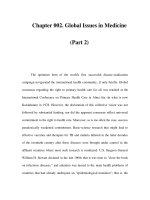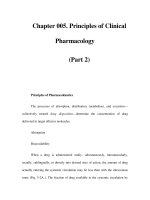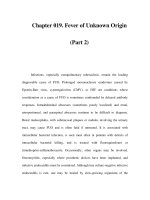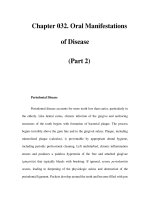Chapter 125. Health Care– Associated Infections (Part 2) Organization, Responsibilities, and pptx
Bạn đang xem bản rút gọn của tài liệu. Xem và tải ngay bản đầy đủ của tài liệu tại đây (14.8 KB, 5 trang )
Chapter 125. Health Care–
Associated Infections
(Part 2)
Organization, Responsibilities, and Increasing Scrutiny of Infection-
Control Programs
The standards of the Joint Commission on Accreditation of Healthcare
Organizations require all accredited hospitals to have an active program for
surveillance, prevention, and control of nosocomial infections. Education of
physicians in infection control and health care epidemiology is required in
infectious disease fellowship programs and is available by online courses.
Diagnosis-related reimbursement has led hospital administrators to place increased
emphasis on infection control. Federal concerns over "patient safety" have led to
legislation that would limit reimbursement for hospital costs resulting from at least
two (yet-to-be-determined) nosocomial infections. The patient safety movement
has prompted major national efforts to improve, measure, and publicly report on
processes of patient care (e.g., timely administration and appropriateness of
perioperative antibiotic prophylaxis) and patient outcomes (e.g., surgical wound
infection rates).
Surveillance
Traditionally, infection-control practitioners have surveyed inpatients for
infections acquired in hospitals (defined as those neither present nor incubating at
the time of admission). Surveillance involves review of microbiology laboratory
results, "shoe-leather" epidemiology on nursing wards, and application of
standardized definitions of infection. Some infection-control programs use
computerized hospital databases for algorithm-driven electronic surveillance (e.g.,
of vascular catheter and surgical wound infections). Commercial health care
information systems that facilitate these functions are considered "value-added"
products.
Most hospitals aim surveillance at infections associated with a high level of
morbidity or expense. Quality-improvement activities in infection control have led
to increased surveillance of personnel compliance with infection-control policies
(e.g., adherence to influenza vaccination recommendations). The growing number
of states that require public reporting of processes for prevention of health care–
associated infection and/or patient outcomes has added new complexity to what
hospitals measure and how they measure it.
Results of surveillance are expressed as rates. In general, 5–10% of patients
develop nosocomial infections—a rate that, as patient advocates emphasize, has
remained unchanged for 20–30 years. However, such broad statistics have little
value unless qualified by duration of risk, by site of infection, by patient
population, and by exposure to risk factors. Meaningful denominators for infection
rates include the number of patients exposed to a specific risk (e.g., patients using
mechanical ventilators) or the number of intervention days (e.g., 1000 patient-days
on a ventilator).
Temporal trends in rates should be reviewed, and rates should be compared
with regional and national benchmarks. However, even comparison rates
generated by the National Healthcare Safety Network (NHSN) have not been
validated independently and represent a nonrandom sample of hospitals. [NHSN is
the successor to the National Nosocomial Infections Surveillance System, a
program of the Centers for Disease Control and Prevention (CDC) that collected
data from more than 350 hospitals that use standardized definitions of nosocomial
infections.] Interhospital comparisons may be misleading because of the wide
range in risk factors and severity of underlying illnesses. Although systems for
making adjustments for these factors either are rudimentary or have not been well
validated, process measures (e.g., adherence to hand hygiene) do not usually
require risk adjustment, and outcome measures (e.g., cardiac surgery wound
infection rates) can identify hospitals with higher infection rates (e.g., in the top
quartile) for further evaluation. Moreover, temporal analysis of an individual
hospital's process and infection outcome rates helps to determine whether control
measures are succeeding and where increased efforts should be focused.
Epidemiologic Basis and General Measures for Prevention and Control
Nosocomial infections follow basic epidemiologic patterns that can help to
direct prevention and control measures. Nosocomial pathogens have reservoirs,
are transmitted by predictable routes, and require susceptible hosts. Reservoirs and
sources exist in the inanimate environment (e.g., tap water contaminated with
Legionella) and in the animate environment (e.g., infected or colonized health care
workers, patients, and hospital visitors). The mode of transmission usually is either
cross-infection (e.g., indirect spread of pathogens from one patient to another on
the inadequately cleaned hands of hospital personnel) or autoinoculation (e.g.,
aspiration of oropharyngeal flora into the lung along an endotracheal tube).
Occasionally, pathogens (e.g., group A streptococci and many respiratory viruses)
are spread from person to person via infectious droplets released by coughing or
sneezing. Much less common—but often devastating in terms of epidemic risk—is
true airborne spread of droplet nuclei (as in nosocomial chickenpox) or common-
source spread by contaminated materials (e.g., contaminated intravenous fluids).
Factors that increase host susceptibility include underlying conditions and the
many medical-surgical interventions and procedures that bypass or compromise
normal host defenses.
Through their programs, hospitals' infection-control committees must
determine general and specific control measures. Given the prominence of cross-
infection, hand hygiene is the single most important preventive measure in
hospitals. Health care workers' rates of adherence to hand-hygiene
recommendations are abysmally low (<50%). Reasons cited include
inconvenience, time pressures, and skin damage from frequent washing. Sinkless
alcohol rubs are quick and highly effective and actually improve hand condition
since they contain emollients and allow the retention of natural protective oils that
would be removed with repeated rinsing. Use of alcohol hand rubs between patient
contacts is now recommended for all health care workers except when the hands
are visibly soiled, in which case washing with soap and water is still required.









